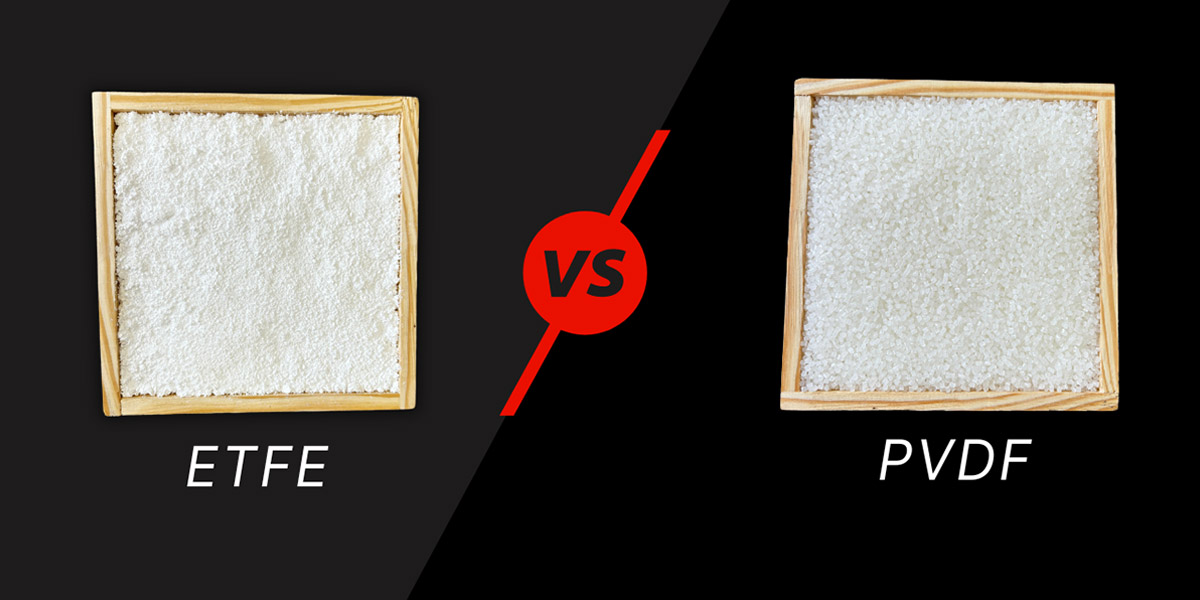ETFE vs PVDF: A Comparative Analysis of Their Differences

When considering high-performance polymers, two materials that are brought into discussion the most are Ethylene Tetrafluoroethylene (ETFE) and Polyvinylidene Fluoride (PVDF).
While both are members of the fluoropolymer family, differences in their characteristics make them fit for different uses.
This blog post is all about discussing the major dissimilation between ETFE and PVDF concerning their chemical structure, properties, and real-life applications.
ETFE vs PVDF - Key Properties and Characteristics
| Property | ETFE | PVDF |
|---|---|---|
| Chemical Structure | -CH2-CH2-CF2-CF2- | -CH2-CF2- |
| Melting Point | 260°C to 280°C | 150°C to 185°C |
| Thermal Decomposition | Above 340°C | Above 300°C |
| Operating Temperature Range | -70°C to 150°C | -40°C to 150°C |
| Flame Retardancy (LOI) | 30-31 | 44 |
| Mechanical Strength | Higher | Good |
| Dielectric Constant | Low (2.5-2.6) | High (6-8) |
| Chemical Resistance | Excellent | Excellent |
| Solubility | Limited | Soluble in polar organic solvents |
| Key Applications | Architecture, wire/cable insulation | Lithium-ion batteries, coatings |
Chemical Structure: The Foundation of Difference
At the molecular level, ETFE and PVDF share similarities but have crucial differences:
The slight difference in arrangement affects their properties so greatly that they differ in performance as well.
Physical Properties: A Side-by-Side Comparison
Appearance
Both ETFE and PVDF are usually available as translucent particles or white powders and hence bear some resemblance to one another in appearance.
Melting Point
ETFE has a higher melting point due to its molecular structure, which is more rigid, and thus more highly crystalline.
Thermal Stability
While both materials are heat-resistant, ETFE has a slight edge in thermal stability.
Operating Temperature Range
ETFE offers a broader range of usable temperatures, particularly at the lower end of the spectrum.
Flame Retardancy
Both materials are non-combustible in air, but PVDF demonstrates superior flame-retardant properties.
Performance Characteristics: Where They Excel
Mechanical Properties
ETFE is the strongest of all fluoropolymers, which have very good mechanical toughness and outstanding tensile strength, reaching as high as 46 MPa at room temperature. It has high elongation at break, reaching as high as up to 300%. Its creep resistance is superior compared to other fluoropolymers like PTFE and FEP.
Though still not as good as ETFE, PVDF has quite good mechanical strength properties anyway in different kinds of applications. It has high tensile strength with excellent impact resistance and outstanding wear-resistance properties. Talking about creep resistance, PVDF is one of the best in the fluoropolymer family.
Electrical Properties
ETFE is a dielectric material with a low and frequency-stable dielectric constant, of 2.5 to 2.6. Its dielectric constant, even at high frequencies like 10 GHz, remains close to 2.3, where the dielectric loss is at a minimum.
On the other hand, PVDF has a higher value of dielectric constant: its dielectric constant runs in the range of 6-8, with more dielectric loss. However, it possesses unique piezoelectric and thermoelectric properties, making it valuable for specific applications.
Chemical Resistance
Both ETFE and PVDF exhibit excellent chemical resistance, but their solubility differs:
Manufacturing Methods: From Monomers to Polymers
The synthesis of ETFE and PVDF involves different approaches:
PVDF Production
ETFE Production
Real-World Applications: Where ETFE and PVDF Shine
The unique properties of these materials lead to diverse applications across industries:
ETFE Applications
PVDF Applications
Final Thoughts: Choice Between ETFE and PVDF
Even though ETFE and, to some extent, PVDF share some similarities, the differences established make each material best suited for a specific application.
ETFE has higher strength, a wider temperature range, and excellent electrical properties that make it a go-to material for architectural and high-performance wire applications.
Excellent chemical resistance combined with particular electrical characteristics makes PVDF especially suitable for energy storage and protective coatings.
Understanding the differences between these (ETFE and PVDF) materials can help engineers, designers, and industry professionals make appropriate choices according to their needs.
For high-quality ETFE, PVDF, and other fluoropolymers, trust Advecton to deliver. Our specialists are at your service to help you pick the perfect material for your requirements.
Let Advecton help drive innovation within your industry. We are going to be your fluoropolymer solution collaborator for years to come.
